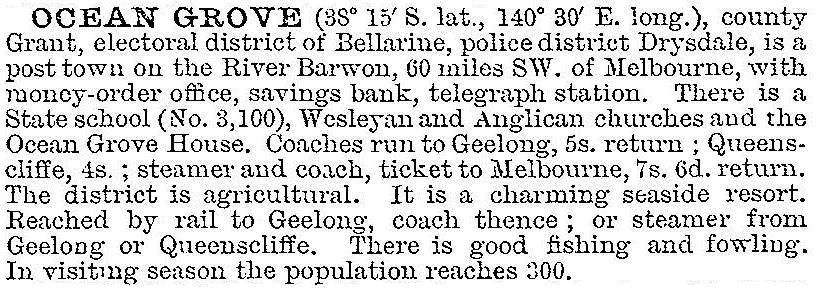Ocean Grove
Ocean Grove and the immediately abutting settlement of Barwon Heads are coastal resort towns, which since the 1960s have become outer suburbs of Geelong, just 19 km away. Because of their coastal topography and a bevy of late nineteenth century churches, both towns retain much of their original charm. The charms of Barwon Heads got national attention in the late 1990s with the Sea Change television series, starring Sigrid Thornton and David Wenham. For 39 episodes ABC viewers could admire the wooden road bridge, the estuary, the jetty and the ‘Beach House’, now a tourist mecca. The series captured the penchant of many Australians to escape the city for the apparent simplicity of life in a small coastal community.
Ocean Grove, a coastal township and beach resort on the southern side of the Bellarine Peninsula, looks out onto Bass Strait. It is 19 km south-east of Geelong, and is situated on the east side of the mouth of the Barwon River, linked by a bridge (1927) to Barwon Heads on the other side of the river.
Origins
In the 1870s the American Methodist church established a Methodist camp at a coastal location in New Jersey. It was named Ocean Grove. In 1879 the American Methodists took their camp idea abroad, and made contact with Melbourne Methodists shortly afterwards. Religious tents attracted good crowds at Royal Park, Melbourne, and at Point Lonsdale. In 1882 it was decided to acquire land for an Australian Ocean Grove.
Melbourne land entrepreneurs during the late 1880s bought up land on the west side of the Barwon River which, until then, had been used by pastoralists and wattle-bark collectors. A proposed Temperance Settlement at the future Ocean Grove had land covenants prohibiting the making or sale of alcoholic beverages. The Methodist church acquired 222 hectares of land and over 30 streets are named after Methodist personalities. A coffee palace (1888) and a guest house were built and a Wesleyan church (1889), primary school (1892) and Anglican church (1896) were opened. The school building was moved from Steiglitz.
Resort
A Geelong and district tourists' guide (1893) described Ocean Grove as a popular watering place, having been visited by thousands of people in its four years of existence. In 1903 the Australian handbook described Ocean Grove:

In addition to the extensive beach, Ocean Grove had river activities, including the Connewarre Yacht Club.
A hall with a free library was opened in 1910, the Methodist church formed a youth camp at Ingemells Park (1920-96) and an active tennis club was formed. There was steady growth during the 1930s and 1940s, and an infant welfare centre was opened in 1949.
Postwar
From the early 1950s many postwar European migrant families settled in Ocean Grove, mainly Dutch, Polish, German and Yugoslav. A Catholic church was opened in 1954. In 1952 when the first Ocean Grove local history was published, its author thought that 'although the town looks more like a Melbourne suburb every day it is no worse than any of the similar surfing towns such as Torquay and Anglesea...'.
Ocean Grove underwent a building boom during the 1970s and 80s, but even during the previous decade it became evident that urban growth would be paramount. In 1962 longtime residents raised money to purchase a 143 hectare piece of land considered to be the last significant bushland in the area. Named the Ocean Grove Nature Reserve, it is a habitat for a rare small blue butterfly which breeds in ant nests.
Ocean Grove has a long foreshore reserve with extensive beaches. The reserve at the river mouth is a slender peninsula, once a camping area but later with restricted summer camping facing the river. The golf course some way upstream has absorbed the former rubbish tip on the river's edge. The shopping centre is a few blocks back from a lookout on the foreshore reserve. It includes the drive-in Ocean Plaza. Nearby there is a community centre and library (replacing the former public hall) and two of Ocean Grove's churches.
The area east of old Ocean Grove was known as Collendina. It has the Shell Road Recreation Reserve, a State primary school (1993) and secondary college (1992) and a Catholic primary school (1982). Nearby is Kingston Park with bushland and walking tracks. As Ocean Grove has expanded it has absorbed Collendina east of Tuckfield Street, and Collendina now begins further east at Bonnyvale Road. Apart from corner stores, residents of Collendina/New Ocean Grove shop in the old town centre or further afield. The Ocean Grove State primary school had 561 pupils in 2014.
Ocean Grove is the largest town on the Bellarine Peninsula. It performs an increasing dormitory role to Geelong, and the number of holiday homes has declined. Visitor accommodation is substantial but has not noticeably increased since the 1980s.
About 4 km offshore from Ocean Grove the former HMAS Canberra was scuttled and opened to divers as an artificial dive reef in 2009.
Ocean Grove's census populations have been:
| area | census date | population |
|---|---|---|
| Ocean Grove | 1891 | 136 |
| 1933 | 139 | |
| 1947 | 472 | |
| 1953 | 1353 | |
| 1961 | 1609 | |
| Ocean Grove & Barwon Heads | 1976 | 5385 |
| 1991 | 10,069 | |
| 2001 | 12,582 | |
| Ocean Grove | 2006 | 11,274 |
| 2011 | 12,555 |
Further Reading
R.G. Edwards, The history of Ocean Grove, The Edina Press, Lower Ferntree Gully, 1952 (50 copies only)
Gil McKeown, The Grove that grew: the history of Ocean Grove, Bellarine on-line, 1983
Helen and Cliff Prowse, Ocean Grove: a century of Christian witness 1888-1988, The Ocean Grove Uniting Church, 1988
Cheryl Timbury, Historic Ocean Grove: a walking tour, vols 1 to 4, Ocean Grove Park (Ingamells) Inc, 1997-1999
Alix Townsend, These friendly shores: a personal history of Ocean Grove, the author, 1988


